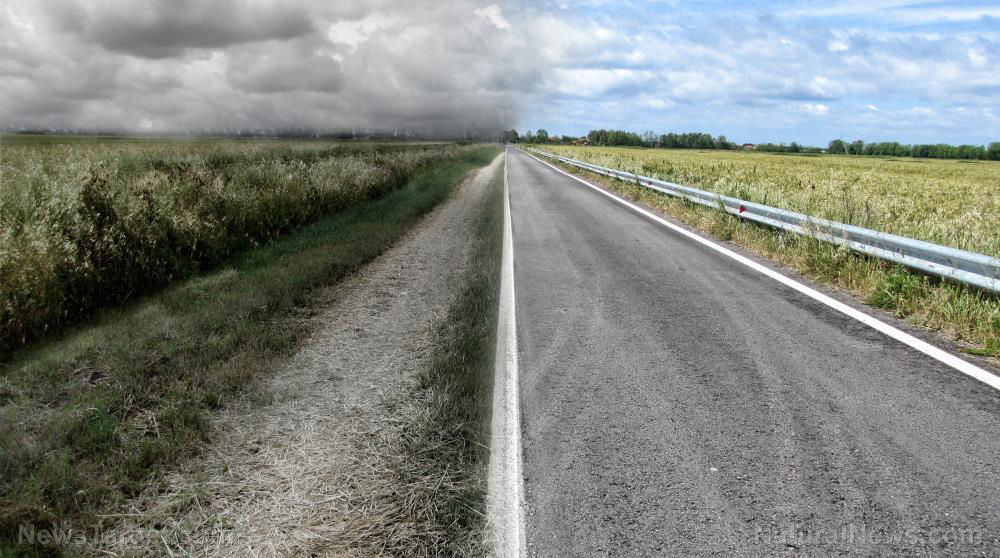“Wormnado” – Hundreds of worms cluster into a tornado-like pattern on New Jersey sidewalk
04/03/2021 / By Virgilio Marin

Earthworms typically tunnel to the surface after a rainstorm and writhe on top of the soil and sidewalks. But a pack of worms in New Jersey did more than just litter the ground after a heavy downpour.
On March 25, a woman from Hoboken spotted hundreds of worms congregating to form a weird, tornado-like shape on a walkway near Maxwell Place Park. The woman, who asked not to be named, said that the worms were not actively forming a spiral when she arrived. She found the creepy crawlers writhing and spread out all over the place, clinging on the wall of a nearby building or dribbling down the curb and into the road.
She snapped pictures of the “wormnado” and sent them to Hoboken City Council member Tiffanie Fisher, who shared them on Facebook.
“Has anyone ever seen anything like this?” Fisher wrote in the post. “This is a tornado of worms that were out this morning near Maxwell Park in Hoboken.”
Why did the worms form a spiral?
Worms breathe through their skin, so they resurface after heavy or persistent rainfall to avoid drowning. While earthworms are typically solitary, they sometimes form “herds” – dense knots made up of tens to thousands of worms – when they are on the surface.
According to a 2010 study, earthworms of the species Eisenia fetida form clusters because they use touch instead of chemical signals to “influence each other to select a common direction during their migration.” This collective behavior helps them survive threats such as flooding, drought and predators.
In 2015, for example, park rangers at Eisenhower State Park in Texas found several masses of live pink earthworms on the park’s backroad after heavy flooding. Officials surmised that the worms clumped together for protection and as a form of group communication.
But these worms congregated in lumps while those at Hoboken, whose species remains unknown, were spread thinly in a spiral.
“This tornado shape is really interesting,” Kyungsoo Yoo, a professor of soil and climate science at the University of Minnesota, told Live Science. Yoo said that though worms are known for emerging en masse from the soil after rain, he had never seen them form a spiral before.
Some people online opined that biblical plagues were behind the bizarre cluster while others argued that the worms were preparing for the “Worm Moon,” the supermoon that brightened the sky on March 28.
Others speculated that the creatures were in the middle of a “death spiral,” a phenomenon commonly observed in army ants that has gotten separated from their colony. These army ants eventually lose their colony’s pheromone trail and begin following each other in an endless loop until they die of exhaustion. Besides army ants, the death spiral has also been observed in caterpillars and koi fish.
Another theory was that a small electromagnetic field created by nearby lampposts messed up the worm’s navigation. Some worms have magnetosensation, or the ability to sense magnetic fields, which they use to find food and navigate their surroundings. (Related: Worms are cool: They can regrow their brains if they lose their heads.)
Wormnado may be a sign of a sinkhole
Saad Bhamla, an assistant professor of chemical and biomolecular engineering at the Georgia Institute of Technology (Georgia Tech), suggested that sudden changes in the soil’s water, along with the shape of the landscape, could explain the appearance of the wormnado.
“The ground there could be dipped,” Bhamla told Live Science. “If the water drained that way after flooding, the worms could be following a water gradient.”
Bhamla and his colleagues observed this type of behavior before in California blackworms, which form an enormous living knot known as “blobs” when threatened by dry conditions. “We’ve seen them follow trails of water and form all kinds of paths and aggregate structures. These aggregations occur once water leaves,” Bhamla said.
Harry Tuazon, a doctoral candidate at Georgia Tech’s Interdisciplinary Bioengineering Graduate Program, also thought that the circular pattern might have been indicative of water draining.
“Perhaps a sinkhole is forming? It would be interesting if a bunch of earthworms provided telltale signs of a forming sinkhole,” he remarked. Sinkholes form when groundwater dissolves the rock below the surface, creating cavities. The surface usually stays intact for a while until the cavities have grown too big, at which point the land caves in. (Related: Scientists to investigate mysterious underwater sinkhole off Florida coast.)
In any case, whatever caused the wormnado probably didn’t last. The woman who took the picture said that the swirl had disappeared when she returned to the park a few hours later, though worms were still all over the place.
Learn more about animals and their amazing biology at Ecology.news.
Sources include:
Tagged Under: animals, earthworms, Ecology, environment, magnetosensation, science, sinkhole, soil health, tornado, Unexplained, weather, weird science, worm moon, worms
RECENT NEWS & ARTICLES
COPYRIGHT © 2017 ECOLOGY NEWS





















